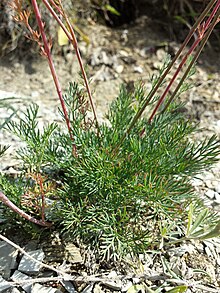Horse chair
| Horse chair | ||||||||||||
|---|---|---|---|---|---|---|---|---|---|---|---|---|

Horse chair ( Seseli hippomarathrum ) |
||||||||||||
| Systematics | ||||||||||||
|
||||||||||||
| Scientific name | ||||||||||||
| Seseli hippomarathrum | ||||||||||||
| Jacq. |
The horse donkey ( Seseli hippomarathrum ), also called horse dill , is a species of plant within the umbelliferae family (Apiaceae).
description
Vegetative characteristics
The horse stool is a perennial herbaceous plant that usually reaches heights of 15 to 50 centimeters. The bare stalk has a tuft of dead leaves at the base. The approximately 10 to 20 centimeters long blue-green leaves are three to four times pinnate to pinnate. The tips of the leaves are narrow, linear and around one millimeter wide. The stalks of the basal leaves are deepened in a groove-like manner.
Generative characteristics
The flowering time of the horse stool extends from July to October in Central Europe . The double umbels usually have no bracts and five to twelve umbel rays, which are downy hairy at least on the inside. The husk leaves of the small cones are grown together like a cup almost to the tip. The flower stalks are 1 to 2 millimeters long. Sepals are mostly indistinct. The petals are white and glabrous. The front edge of the petals is outlined to notched. The petal wing is a maximum of a quarter as long as the petal. The hammered lobule ( lobulum inflexum ) is belt-shaped and one fifth as long to as long as the petal without wings. The fruit is ribbed.
The chromosome number of the species is 2n = 20.
ecology
The horse donkey is a hemicryptophyte .
distribution
The horse-drawn donkey is indigenous in Austria , Germany , the Czech Republic , Slovakia , Hungary , Croatia , Serbia , Romania and the Ukraine .
In Austria, the horse-drawn donkey appears in the Pannonian region , but otherwise only rarely, on dry grassland and in pine forests in the colline to submontane altitude range . The occurrences are limited to the federal states of Vienna , Lower Austria and Burgenland . The species is extinct in Upper Austria , otherwise it is considered endangered in Austria.
In Germany and the federal states of Baden-Württemberg, Rhineland-Palatinate and Saxony-Anhalt, the species is endangered. The occurrence of the species is limited to the mentioned federal states. It is a Festucion valesiacae association character, but rarely occurs in Xerobromion societies or in Seslerio Festucion societies.
Individual evidence
- ^ A b c d Manfred A. Fischer, Karl Oswald, Wolfgang Adler: excursion flora for Austria, Liechtenstein and South Tyrol . 3rd, improved edition. Province of Upper Austria, Biology Center of the Upper Austrian State Museums, Linz 2008, ISBN 978-3-85474-187-9 , p. 844 . , taking into account the corrections to the 3rd edition (2008) of the excursion flora for Austria, Liechtenstein and South Tyrol in addition to the list in Neilreichia 5 (2008) in: Neilreichia 6: 297–325 (2011) Online ( Memento of the original from October 20 2013 in the Internet Archive ) Info: The archive link was inserted automatically and has not yet been checked. Please check the original and archive link according to the instructions and then remove this notice. (PDF; 735 kB)
- ↑ a b Erich Oberdorfer : Plant-sociological excursion flora for Germany and neighboring areas . 8th edition. Stuttgart, Verlag Eugen Ulmer, 2001. ISBN 3-8001-3131-5
- ↑ Entry in The Euro + Med PlantBase - the information resource for Euro-Mediterranean plant diversity, accessed on August 4, 2013
- ^ Entry from Floraweb, accessed June 10, 2014
- ↑ Distribution map of Floraweb, accessed on June 10, 2014
Web links
- Horse chair. In: FloraWeb.de.
- Profile and distribution map for Bavaria . In: Botanical Information Hub of Bavaria .
- Horse chair . In: BiolFlor, the database of biological-ecological characteristics of the flora of Germany.
- Data sheet and pictures at Blumen in Swabia
- Description at "Botanik im Bild" (Natural History Museum Vienna)

